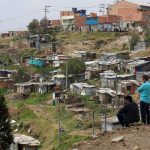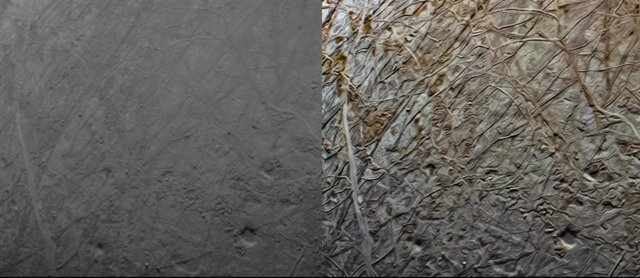This pair of images shows the same portion of Europa captured by the Juno spacecraft’s JunoCam during the mission’s close flyby on September 29. – NASA/JPL- NAVANEETH KRISHNAN S CC BY
Oct. 7 () –
Amateur scientists have provided unique insights into the recent close flyby of Jupiter’s icy moon Europa. by NASA’s Juno spacecraft.
When processing JunoCam imagesthe spacecraft’s public engagement camera, have created deep space portraits of the Jovian moon that are not only impressive, but also deserve further scientific scrutiny, according to NASA.
“Since our flyby of Earth in 2013, Juno citizen scientists have been invaluable in processing the many images we get with Juno,” said Scott Bolton, Juno principal investigator from the Southwest Research Center in San Antonio. “During every flyby of Jupiter, and now its moons, their work provides a perspective that draws on both science and art. They are a crucial part of our team, leading the way by using our images for new discoveries.” These latest images of Europa do just that, pointing us to surface features that reveal details about how Europa works. and what might be lurking both on top of the ice and below.”
JunoCam took four photos during its flyby of Europe on September 29. The closest, 1,521 kilometers above a region of the moon called Annwn Regio.
In the image, the terrain next to the boundary between day and night is revealed to be rugged, with pits and depressions. Numerous bright and dark ridges and bands stretch across a fractured surface, revealing tectonic stresses the moon has endured for millennia. The dark circular feature at lower right is Callanish Crater.
These JunoCam images help fill in the gaps in the maps of the images obtained by NASA’s Voyager and Galileo missions. Citizen scientist Björn Jónsson processed the image to improve color and contrast. The resolution is about 1 kilometer per pixel.
JunoCam images processed by citizen scientists they often span the worlds of science and art. In the image processed by Navaneeth Krishnan, the enhanced color contrast makes larger surface features stand out more than in the lightly processed version of the image (left).
An example of the results can be seen at the bottom right of the enhanced image, where the pits and a small block cast noticeable shadows. The small-scale texture of the image surface must be studied carefully to distinguish between features and processing artifactsbut the image plunges us deeper into the alien landscape of Europa.
Citizen scientist Fernando García Navarro applied his artistic talents to create another striking image. He downloaded and processed an image that citizen scientist Kevin M. Gill had previously worked on, producing a psychedelic rendering he titled “Autumn Colors of Europe”.



![[Img #74674]](https://thelatestnews.world/wp-content/uploads/2024/12/Santiago-Ramon-y-Cajal-The-promoter-of-modern-neuroscience-150x150.jpg)








![[Img #74674]](https://thelatestnews.world/wp-content/uploads/2024/12/Santiago-Ramon-y-Cajal-The-promoter-of-modern-neuroscience-300x200.jpg)

